Influence of Anodizing by Electro-Chemical Oxidation on Fatigue and Wear Resistance of the EV31A-T6 Cast Magnesium Alloy
Abstract
:1. Introduction
2. Materials and Methods
2.1. Microstructural Characterization
2.2. Tribological Tests
2.3. Fatigue Tests
3. Results
3.1. Microstructural Characterization
3.2. Dry Sliding Tests
3.3. Fatigue Tests
4. Conclusions
- Less intense micro arcs generated by the discharge regime in the ECO process resulted in a denser anodized layer than in PEO.
- In dry sliding tests vs. 100Cr6 bearing steel, the ECO-treated alloy showed a critical coating failure load one order of magnitude higher than the PEO-treated alloy.
- At 5 N normal load, the maximum wear depth of the ECO-treated alloy was one order of magnitude higher than for PEO-treated samples. In the same conditions, the coefficient of friction of the ECO-treated alloy was about 40% lower than that of PEO-treated samples.
- With the same surface finish, no decrease in fatigue strength was observed for ECO-treated samples compared to the untreated alloy, while the industrial PEO-treated samples induced a 15% fatigue strength decrease.
Author Contributions
Funding
Institutional Review Board Statement
Informed Consent Statement
Data Availability Statement
Acknowledgments
Conflicts of Interest
References
- Housh, S.; Mikucki, B.; Stevenson, A. Selection and Application of Magnesium and Magnesium Alloys. In ASM Handbook, Volume 2: Properties and Selection: Nonferrous Alloys and Special-Purpose Materials; ASM International: Novelty, OH, USA, 1990; pp. 455–479. [Google Scholar]
- Peng, L.; Fu, P.; Li, Z.; Wang, Y.; Jiang, H. High cycle fatigue properties of cast Mg–xNd–0.2Zn–Zr alloys. J. Mater. Sci. 2014, 49, 7105–7115. [Google Scholar] [CrossRef]
- Pan, F.; Yang, M.; Chen, X. A Review on Casting Magnesium Alloys: Modification of Commercial Alloys and Development of New Alloys. J. Mater. Sci. Technol. 2016, 32, 1211–1221. [Google Scholar] [CrossRef]
- Peng, L.M.; Fu, P.H.; Li, Z.M.; Yue, H.Y.; Li, D.Y.; Wang, Y.X. High cycle fatigue behaviors of low pressure cast Mg-3Nd-0.2Zn-2Zr alloys. Mater. Sci. Eng. A 2014, 611, 170–176. [Google Scholar] [CrossRef]
- Wang, F.; Dong, J.; Jiang, Y.; Ding, W. Cyclic deformation and fatigue of extruded Mg-Gd-Y magnesium alloy. Mater. Sci. Eng. A 2013, 561, 403–410. [Google Scholar] [CrossRef]
- Stanford, N.; Barnett, M. Effect of composition on the texture and deformation behaviour of wrought Mg alloys. Scr. Mater. 2008, 58, 179–182. [Google Scholar] [CrossRef]
- Hadorn, J.P.; Hantzsche, K.; Yi, S.; Bohlen, J.; Letzig, D.; Agnew, S.R. Effects of solute and second-phase particles on the texture of Nd-containing Mg alloys. Metall. Mater. Trans. A 2012, 43, 1363–1375. [Google Scholar] [CrossRef]
- Mirza, F.A.; Chen, D.L.; Li, D.J.; Zeng, X.Q. Effect of rare earth elements on deformation behavior of an extruded Mg-10Gd-3Y-0.5Zr alloy during compression. Mater. Des. 2013, 46, 411–418. [Google Scholar] [CrossRef]
- Wu, G.; Fan, Y.; Gao, H.; Zhai, C.; Zhu, Y.P. The effect of Ca and rare earth elements on the microstructure, mechanical properties and corrosion behavior of AZ91D. Mater. Sci. Eng. A 2005, 408, 255–263. [Google Scholar] [CrossRef]
- Mohedano, M.; Arrabal, R.; Pardo, A.; Paucar, K.; Merino, M.C.; Matykina, E.; Mingo, B.; Garcés, G. Galvanic corrosion of rare earth modified AM50 and AZ91D magnesium alloys coupled to steel and aluminium alloys. Rev. Metal 2014, 50, e002. [Google Scholar]
- Riontino, G.; Lussana, D.; Massazza, M.; Barucca, G.; Mengucci, P.; Ferragut, R. Structure evolution of EV31 Mg alloy. J. Alloys Compd. 2008, 463, 200–206. [Google Scholar] [CrossRef]
- Magnesium Alloy Castings. Sand 2.8Nd–1.4Gd–0.4Zn–0.6Zr (EV31A–T6) Solution and Precipitation Heat Treated, Revision A; AMS4429; SAE International: Warrendale, PA, USA, 2012. [Google Scholar]
- Chandra, D.; Chauhan, N.R. Surface protective coatings on Mg alloys—A review. Mater. Today Proc. 2021, 47, 3819–3822. [Google Scholar] [CrossRef]
- Wang, J.; Pang, X.; Jahed, H. Surface protection of Mg alloys in automotive applications: A review. AIMS Mater. Sci. 2019, 6, 567–600. [Google Scholar] [CrossRef]
- Gray, J.E.; Luan, B. Protective coatings on magnesium and its alloys—A critical review. J. Alloys Compd. 2002, 336, 88–113. [Google Scholar] [CrossRef]
- Barati Darband, G.; Aliofkhazraei, M.; Hamghalam, P.; Valizade, N. Plasma electrolytic oxidation of magnesium and its alloys: Mechanism, properties and applications. J. Magnes. Alloys 2017, 5, 74–132. [Google Scholar] [CrossRef]
- Arrabal, R.; Mohedano, M.; Matykina, E. Electrochemical Surface Treatments for Mg Alloys. In Encyclopedia of Materials: Metals and Alloys, 1st ed.; Caballero, F.G., Ed.; Elsevier: Amsterdam, The Netherlands, 2022; pp. 87–112. [Google Scholar]
- Blawert, C.; Bala Srinivasan, P. 6—Plasma electrolytic oxidation treatment of magnesium alloys. In Surface Engineering of Light Alloys, 1st ed.; Dong, H., Ed.; Woodhead Publishing: Cambridge, UK, 2010; pp. 155–183. [Google Scholar]
- Yerokhin, A.L.; Shatrov, A.; Samsonov, V.; Shashkov, P.; Leyland, A.; Matthews, A. Fatigue properties of Keronite® coatings on a magnesium alloy. Surf. Coat. Technol. 2004, 182, 78–84. [Google Scholar] [CrossRef]
- Vladimirov, B.V.; Krit, B.L.; Lyudin, V.B.; Morozova, N.V.; Rossiiskaya, A.D.; Suminov, I.V.; Epel’feld, A.V. Microarc oxidation of magnesium alloys: A review. Surf. Engin. Appl. Electrochem. 2014, 50, 195–232. [Google Scholar] [CrossRef]
- Klein, M.; Lu, X.; Blawert, C.; Kainer, K.U.; Zheludkevich, M.L.; Walther, F. Influence of plasma electrolytic oxidation coatings on fatigue performance of AZ31 Mg alloy. Corros. Mater. 2017, 68, 50–57. [Google Scholar] [CrossRef]
- Němcová, A.; Skeldon, P.; Thompson, G.E.; Morse, S.; Čížek, J.; Pacal, B. Influence of plasma electrolytic oxidation on fatigue performance of AZ61 magnesium alloy. Corros. Sci. 2014, 82, 58–66. [Google Scholar] [CrossRef]
- Hussein, R.O.; Northwood, D.O.; Su, J.F.; Nie, X. A study of the interactive effects of hybrid current modes on the tribological properties of a PEO (plasma electrolytic oxidation) coated AM60B Mg-alloy. Surf. Coat. Technol. 2013, 215, 421–430. [Google Scholar] [CrossRef]
- Saji, V.S. Review of rare-earth-based conversion coatings for magnesium and its alloys. Mater. Res. Technol. 2019, 8, 5012–5035. [Google Scholar] [CrossRef]
- Liu, C.; Lu, X.; Li, Y.; Chen, Q.; Zhang, T.; Wang, F. Influence of post-treatment process on corrosion and wear properties of PEO coatings on AM50 Mg alloy. J. Alloys Compd. 2021, 870, 159462. [Google Scholar] [CrossRef]
- Sola, R.; Tonelli, L.; Shashkov, P.; Bogdanoff, T.H.; Martini, C. Anodizing of AA6082-T5 by conventional and innovative treatments: Microstructural characterization and dry sliding behaviour. Wear 2020, 458–459, 203423. [Google Scholar] [CrossRef]
- De Oliveira, L.A.; dos Santos, S.L.; de Oliveira, V.A.; Antunes, R.A. Influence of Anodization on the Fatigue and Corrosion-Fatigue Behaviors of the AZ31B Magnesium Alloy. Metals 2021, 11, 1573. [Google Scholar] [CrossRef]
- Tonelli, L.; Pezzato, L.; Dolcet, P.; Dabalà, M.; Martini, C. Effects of graphite nano-particle additions on dry sliding behaviour of plasma-electrolytic-oxidation-treated EV31A magnesium alloy against steel in air. Wear 2018, 404–405, 122–132. [Google Scholar] [CrossRef]
- Ceschini, L.; Morri, A.; Angelini, V.; Messieri, S. Fatigue Behavior of the Rare Earth Rich EV31A Mg Alloy: Influence of Plasma Electrolytic Oxidation. Metals 2017, 7, 212. [Google Scholar] [CrossRef]
- International Organization for Standardization. ISO 1143:2021; Metallic Materials—Rotating Bar Bending Fatigue Testing. International Organization for Standardization: Geneva, Switzerland, 2021.
- Angelini, V.; Ceschini, L.; Morri, A.; Apelian, D. Influence of Heat Treatment on Microstructure and Mechanical Properties of Rare Earth-Rich Magnesium Alloy. Inter. Metalcast. 2017, 11, 382–395. [Google Scholar] [CrossRef]
- ASTM G77-17; Standard Test Method for Ranking Resistance of Materials to Sliding Wear Using Block-on-Ring Wear Test. ASTM International: West Conshohocken, PA, USA, 2017.
- Williams, J.A.; Dwyer-Joyce, R.S. Contact between solid surfaces. In Modern Tribology Handbook, 1st ed.; Bhushan, B., Ed.; CRC Press LLC: Boca Raton, FL, USA, 2000; pp. 121–162. [Google Scholar]
- Subvol, B. II-VI and I-VII Compounds; Semimagnetic Compounds; Madelung, O., Rössler, U., Schulz, M., Eds.; Springer: Berlin/Heidelberg, Germany, 1999; p. 41. [Google Scholar]
- International Organization for Standardization. ISO 12107:2012; Metallic Materials—Fatigue Testing—Statistical Planning and analysis of Data. International Organization for Standardization: Geneva, Switzerland, 2012.
- Nie, J.F. Precipitation and Hardening in Magnesium Alloys. Metall. Mater. Trans. A 2012, 43, 3891–3939. [Google Scholar] [CrossRef] [Green Version]
- Wu, D.; Chen, R.S.; Ke, W. Microstructure and mechanical properties of a sand-cast Mg–Nd–Zn alloy. Mater. Des. 2014, 58, 324–331. [Google Scholar] [CrossRef]
- ASM International. ASM Handbook, Metallography and Microstructures, 1st ed.; George, F., Ed.; Vander Voort ASM International, The Materials Information Society: Materials Park, OH, USA, 2004; Volume 9. [Google Scholar]
- Arrabal, R.; Matykina, E.; Hashimoto, T.; Skeldon, P.; Thompson, G.E. Characterization of AC PEO coatings on magnesium alloys. Surf. Coat. Technol. 2009, 203, 2207–2220. [Google Scholar] [CrossRef]
- Khan, S.A.; Miyashita, Y.; Mutoh, Y.; Koike, T. Effect of anodized layer thickness on fatigue behavior of magnesium alloy. Mater. Sci. Eng. A 2008, 474, 261–269. [Google Scholar] [CrossRef]
- Monfort, F.; Matykina, E.; Berkani, A.; Skeldon, P.; Thompson, G.E.; Habazaki, H.; Shimizu, K. Species separation during coating growth on aluminium by spark anodizing. Surf. Coat. Technol. 2007, 201, 8671–8676. [Google Scholar] [CrossRef]
- Matykina, E.; Arrabal, R.; Scurr, D.J.; Baron, A.; Skeldon, P.; Thompson, G.E. Investigation of the mechanism of plasma electrolytic oxidation of aluminium using 18O tracer. Corros. Sci. 2010, 52, 1070–1076. [Google Scholar] [CrossRef]
- Durdu, S.; Bayramoğlu, S.; Demirtaş, A.; Usta, M.; Üçışık, A.H. Characterization of AZ31 Mg Alloy coated by plasma electrolytic oxidation. Vacuum 2013, 88, 130–133. [Google Scholar] [CrossRef]
- International Organization for Standardization. ISO 20502:2005; Fine Ceramics (Advanced Ceramics, Advanced Technical Ceramics)—Determination of Adhesion of Ceramic Coatings by Scratch Testing. International Organization for Standardization: Geneva, Switzerland, 2005.
- Bull, S.J.; Berasetegui, E.G. An overview of the potential of quantitative coating adhesion measurement by scratch testing. Tribol. Int. 2006, 39, 99–114. [Google Scholar] [CrossRef]
- Srinivasan, P.B.; Liang, J.; Blawert, C.; Dietzel, W. Dry sliding wear behaviour of magnesium oxide and zirconium oxide plasma electrolytic oxidation coated magnesium alloy. Appl. Surf. Sci. 2010, 256, 3265–3273. [Google Scholar] [CrossRef] [Green Version]
- Rapheal, G.; Kumar, S.; Blawert, C.; Dahotre, N.B. Wear behavior of plasma electrolytic oxidation (PEO) and hybrid coatings of PEO and laser on MRI 230D magnesium alloy. Wear 2011, 271, 1987–1997. [Google Scholar] [CrossRef] [Green Version]
- Jiang, B.L.; Wang, Y.M. 5—Plasma electrolytic oxidation treatment of aluminium and titanium alloys. In Surface Engineering of Light Alloys, 1st ed.; Dong, H., Ed.; Woodhead Publishing: Cambridge, UK, 2010; pp. 110–154. [Google Scholar]
- Li, Z.; Wang, Q.; Luo, A.A.; Peng, L.; Zhang, P. Fatigue behavior and life prediction of cast magnesium alloys. Mater. Sci. Eng. A 2015, 647, 113–126. [Google Scholar] [CrossRef]
- Mirza, F.A.; Chen, D.L.; Li, D.J.; Zeng, X.Q. Cyclic Deformation Behavior of a Rare-Earth Containing Extruded Magnesium Alloy: Effect of Heat Treatment. Metall. Mater. Trans. A 2015, 46, 1168–1187. [Google Scholar] [CrossRef]
- Li, Z.; Wang, Q.; Luo, A.A.; Fu, P.; Peng, L.; Wang, Y.; Wu, G. High cycle fatigue of cast Mg-3Nd-0.2Zn magnesium alloys. Metall. Mater. Trans. A 2013, 44, 5202–5215. [Google Scholar] [CrossRef] [Green Version]
- Morri, A.; Ceschini, L.; Martini, C.; Bernardi, A. Influence of Plasma Electrolytic Oxidation on Fatigue Behaviour of ZK60A-T5 Magnesium Alloy. Coatings 2020, 10, 1180. [Google Scholar] [CrossRef]
- Lonyuk, B.; Apachitei, I.; Duszczyk, J. The effect of oxide coatings on fatigue properties of 7475-T6 aluminium alloy. Surf. Coat. Technol. 2007, 201, 8688–8694. [Google Scholar] [CrossRef]
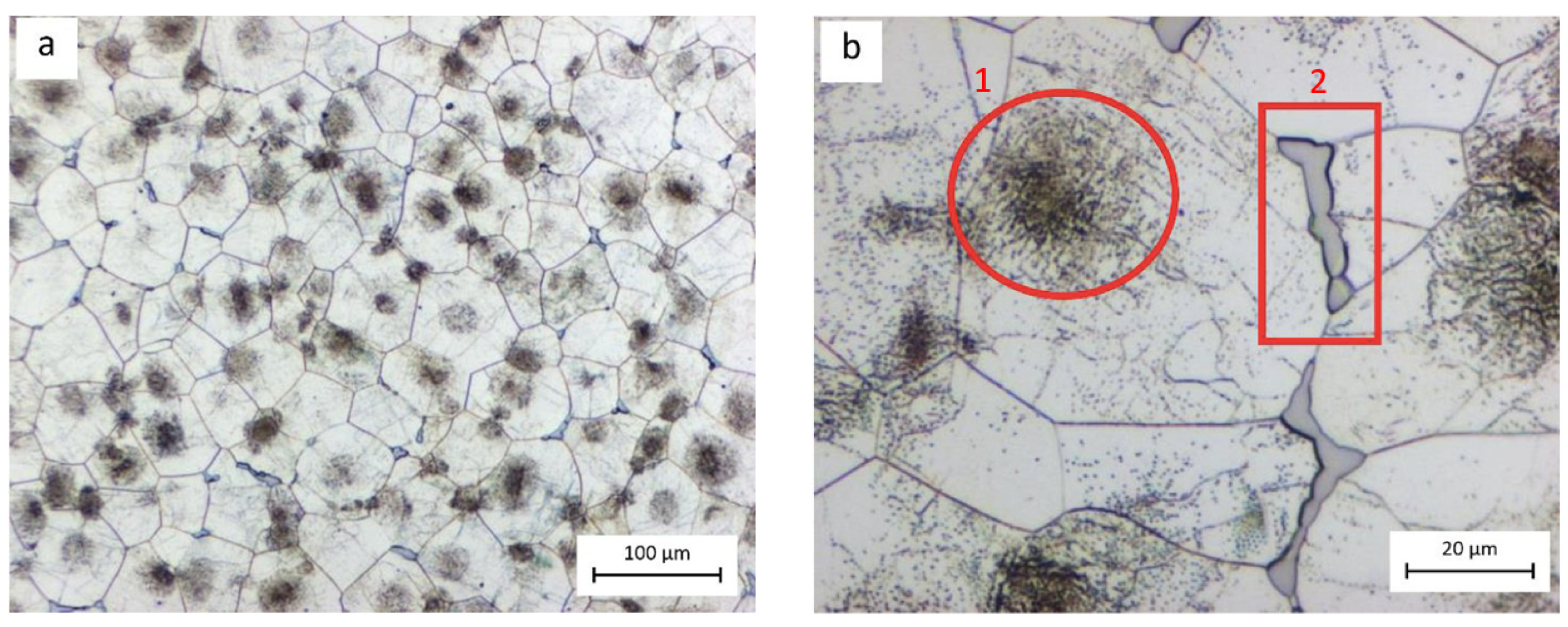
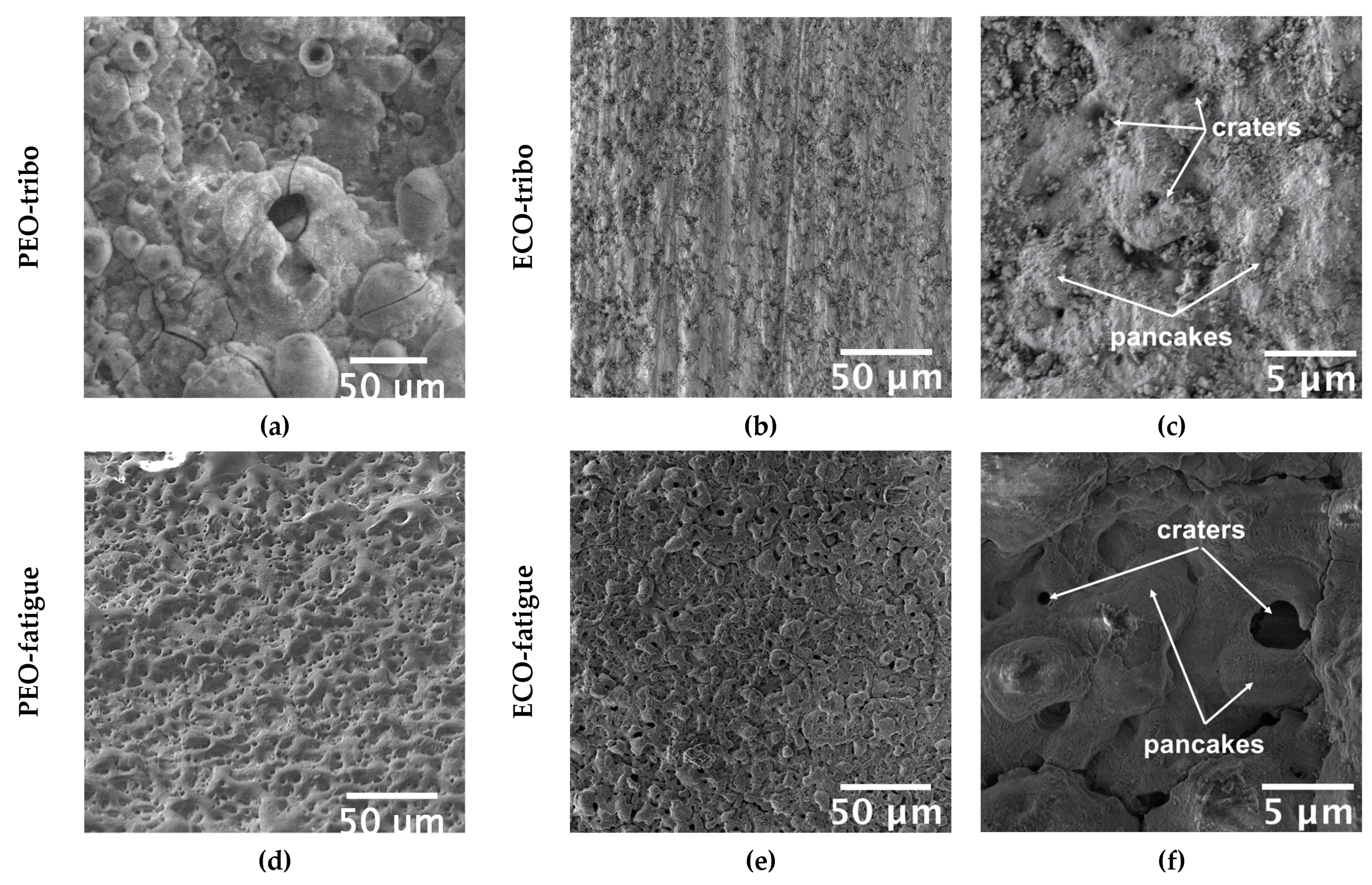
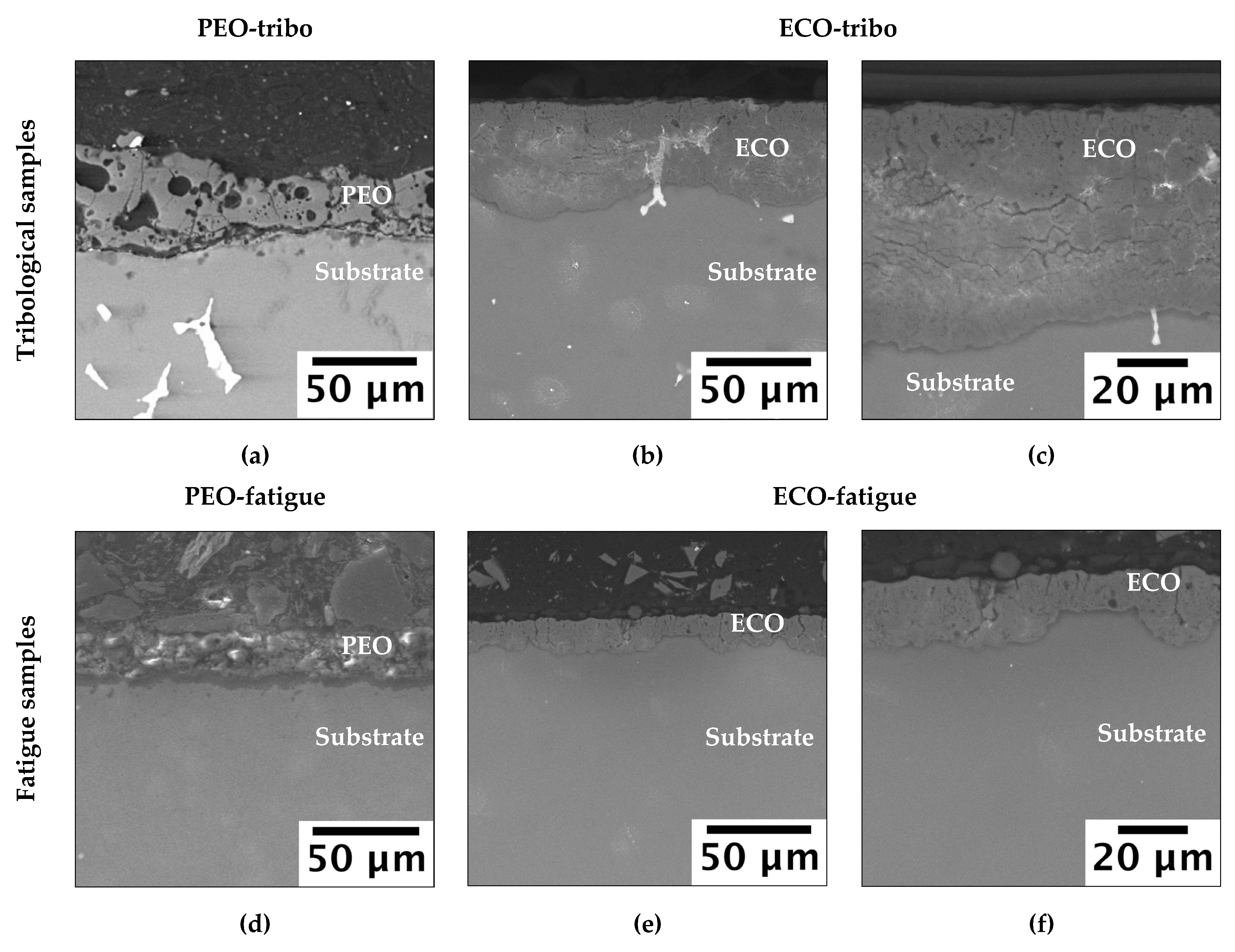
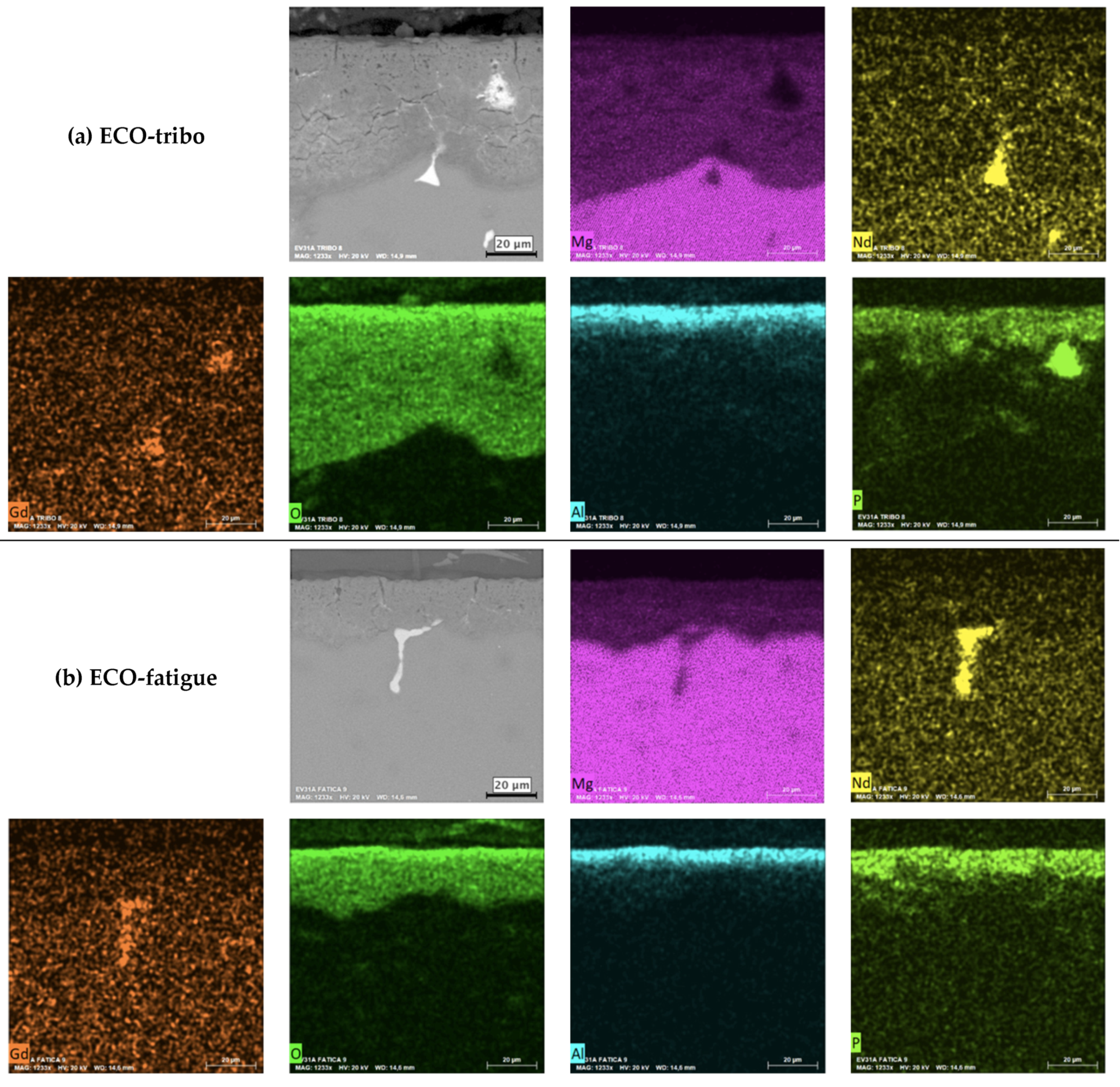


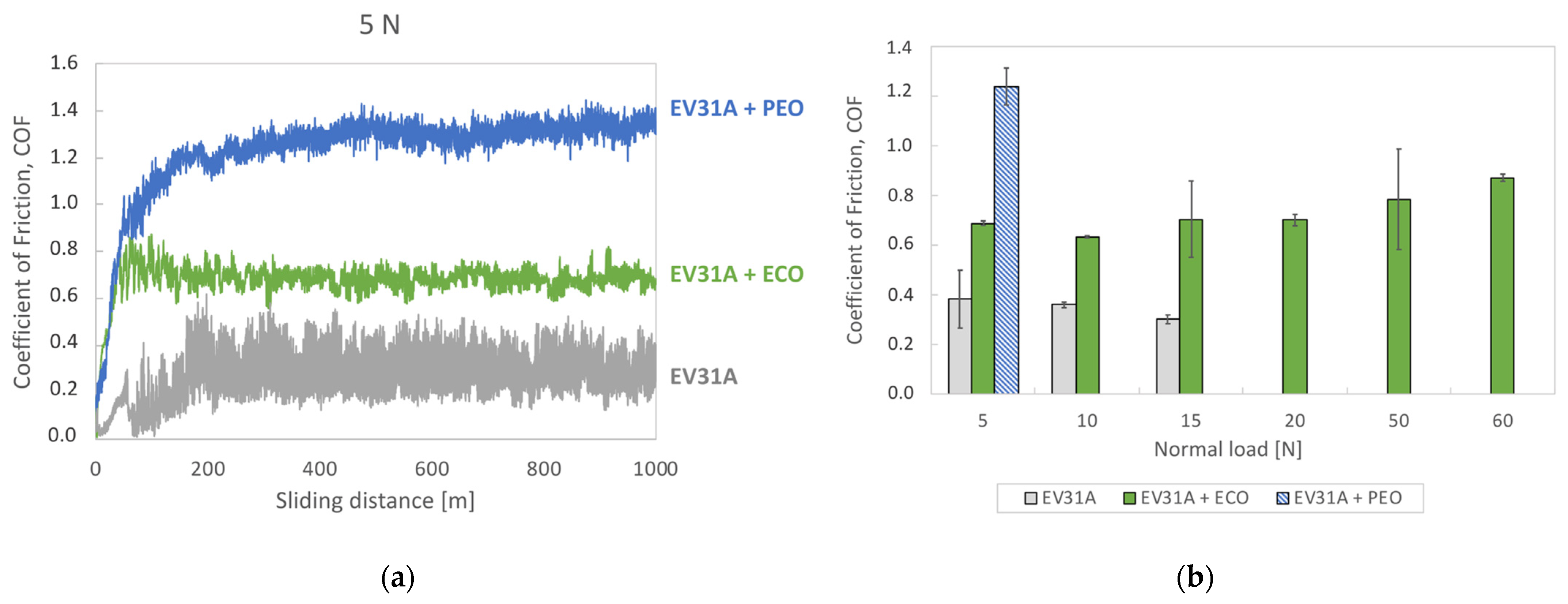

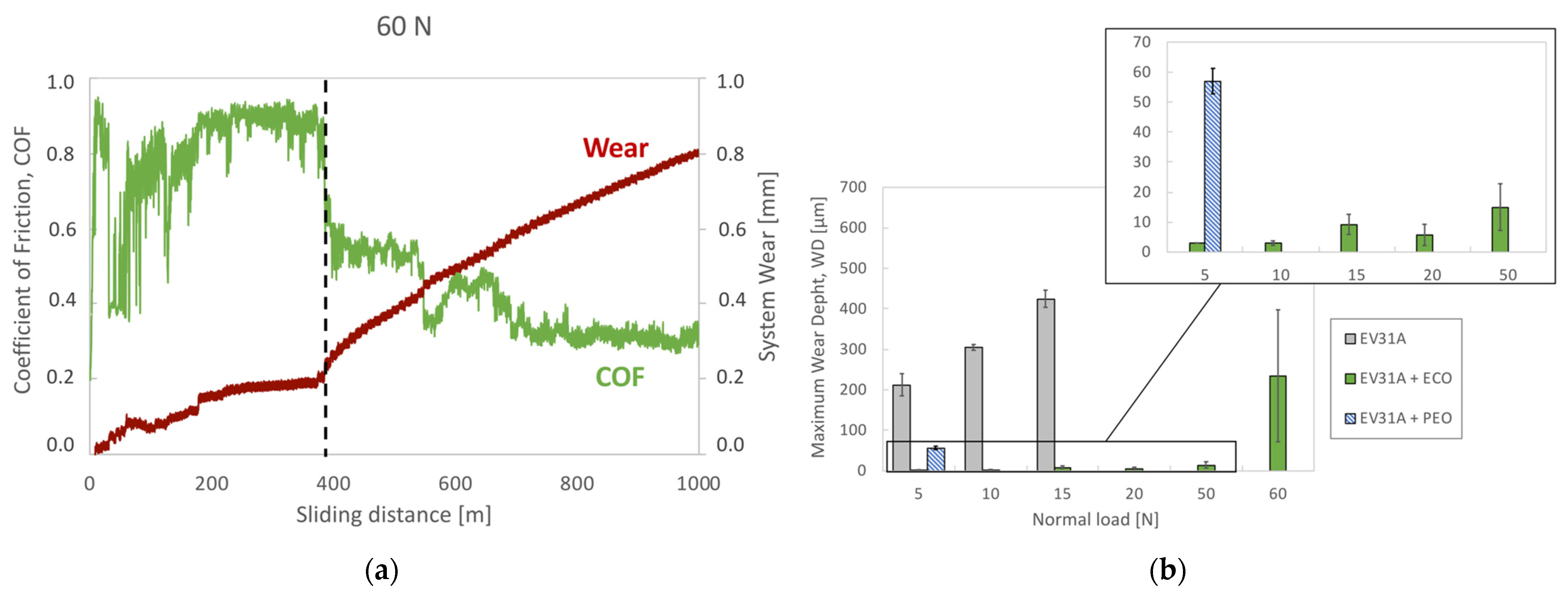

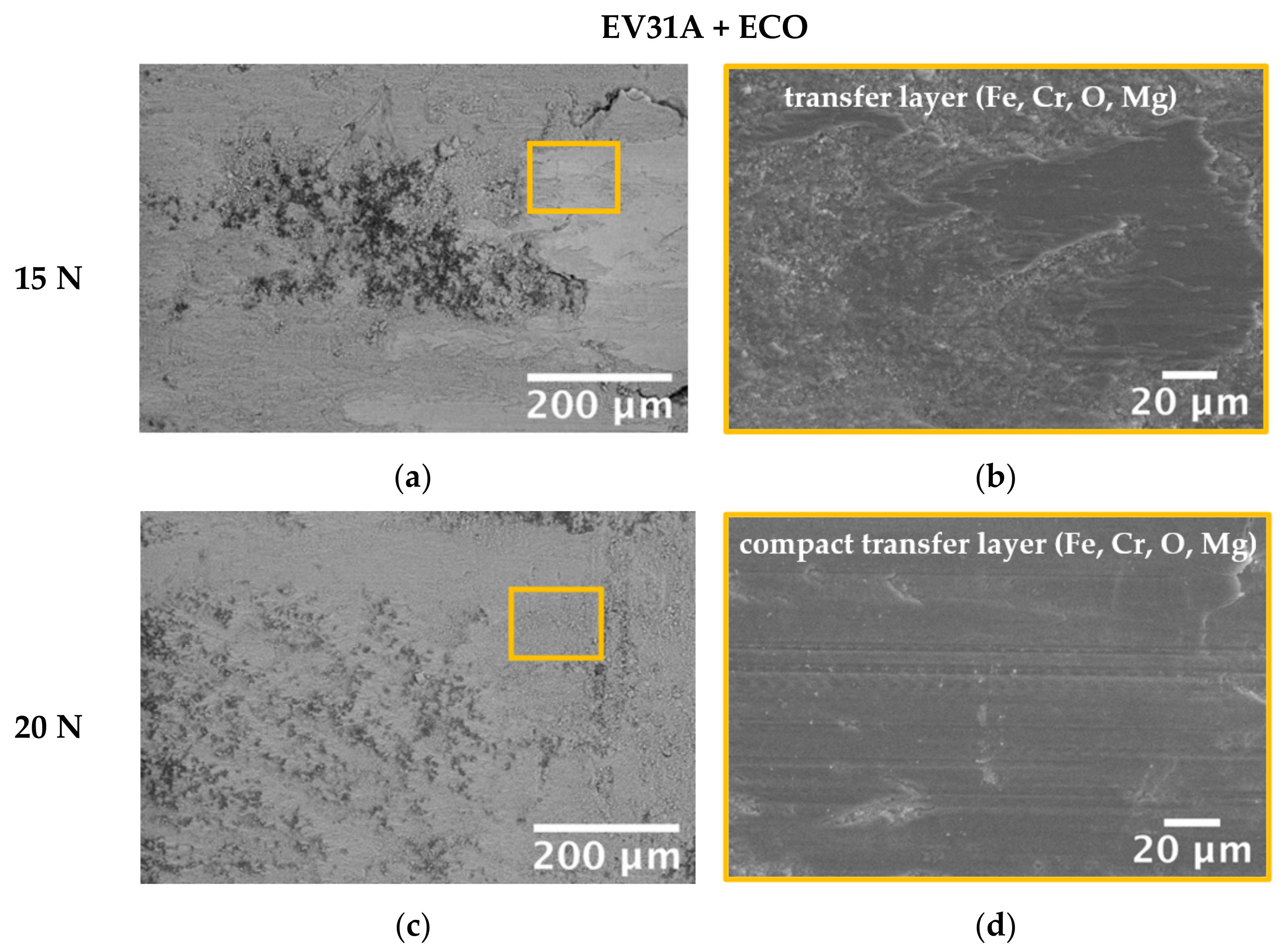


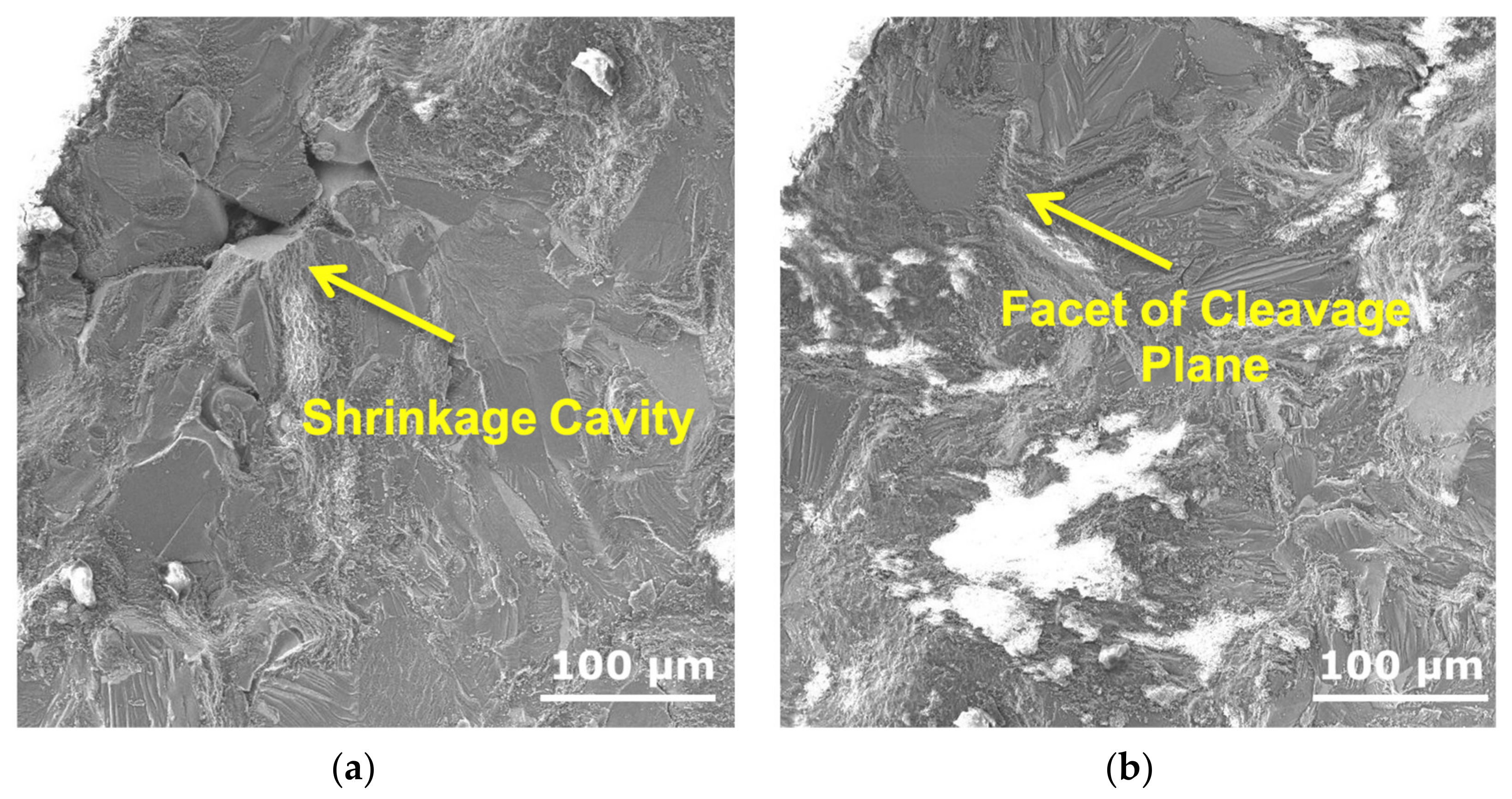


| Nd | Gd | Zr | Zn | Fe | Ni | Cu | Si | Ag | ORE 1 | Mg |
|---|---|---|---|---|---|---|---|---|---|---|
| 2.8 | 1.3 | 0.56 | 0.29 | 0.003 | <0.001 | <0.008 | <0.01 | <0.1 | <0.14 | Bal. |
| Anodizing Parameters | ECO | PEO-Tribo [28] | PEO-Fatigue [29] |
|---|---|---|---|
| Coating mode control | Pulsed bipolar current (PBC): Potentiostatic for anodic pulse; galvanostatic for cathodic pulses | Galvanostatic (DC mode) | MAGOXID® (proprietary process) |
| Voltage (V) | +500 V/−100 V | <200 V | |
| Current density (mA cm−2) | 600 | 500 | |
| Electrolyte | Alkaline phosphate-aluminate solution (KOH, Na4O7P2, NaAlO2 in deionized water) | Alkaline phosphate-silicate solution (Na5P3O10, Na2SiO3, NaOH in deionized water) | |
| Tank temperature (°C) | 20–25 | 20–25 | |
| Discharge mode | Low-discharge oxidation | Micro-discharge oxidation | Micro-discharge oxidation |
| Main Coating Features, Tribological and Fatigue Properties | Dry Sliding | Rotating Bending | ||||||
|---|---|---|---|---|---|---|---|---|
| ECO-Tribo | PEO-Tribo [28] | ECO-Fatigue | PEO-Fatigue [29] | |||||
| Surface roughness, µm | Ra | Rq | Ra | Rq | Ra | Rq | Ra | Rq |
| 0.19 ± 0.04 | 0.24 ± 0.04 | 5.3 ± 0.8 | 6.9 ± 2.0 | 0.30 ± 0.02 | 0.38 ± 0.02 | 2.0 ± 0.1 | 2.4 ± 0.3 | |
| Thickness, µm | 55 ± 6 | 47 ± 10 | 16 ± 4 | 23 ± 3 | ||||
| Phase constitution | MgO | MgO, Mg3(PO4)2, Mg2SiO4 | MgO | MgO, Mg3(PO4)2, Mg2P2O7 | ||||
| Lc3 (scratch test), N | >30 | 21.7 ± 2.6 | 21.1 ± 2.0 | 13.3 ± 0.6 | ||||
| Maximum load before coating failure (dry sliding), N | 50 | 5 | n.a. | n.a. | ||||
| Mean fatigue strength (σD[50%]), MPa | n.a. | n.a. | 109 ± 5 (no decrease in comparison to untreated alloy) | 88 ± 13 (−15% in comparison to untreated alloy) | ||||
Disclaimer/Publisher’s Note: The statements, opinions and data contained in all publications are solely those of the individual author(s) and contributor(s) and not of MDPI and/or the editor(s). MDPI and/or the editor(s) disclaim responsibility for any injury to people or property resulting from any ideas, methods, instructions or products referred to in the content. |
© 2022 by the authors. Licensee MDPI, Basel, Switzerland. This article is an open access article distributed under the terms and conditions of the Creative Commons Attribution (CC BY) license (https://creativecommons.org/licenses/by/4.0/).
Share and Cite
Di Egidio, G.; Tonelli, L.; Morri, A.; Boromei, I.; Shashkov, P.; Martini, C. Influence of Anodizing by Electro-Chemical Oxidation on Fatigue and Wear Resistance of the EV31A-T6 Cast Magnesium Alloy. Coatings 2023, 13, 62. https://doi.org/10.3390/coatings13010062
Di Egidio G, Tonelli L, Morri A, Boromei I, Shashkov P, Martini C. Influence of Anodizing by Electro-Chemical Oxidation on Fatigue and Wear Resistance of the EV31A-T6 Cast Magnesium Alloy. Coatings. 2023; 13(1):62. https://doi.org/10.3390/coatings13010062
Chicago/Turabian StyleDi Egidio, Gianluca, Lavinia Tonelli, Alessandro Morri, Iuri Boromei, Pavel Shashkov, and Carla Martini. 2023. "Influence of Anodizing by Electro-Chemical Oxidation on Fatigue and Wear Resistance of the EV31A-T6 Cast Magnesium Alloy" Coatings 13, no. 1: 62. https://doi.org/10.3390/coatings13010062






